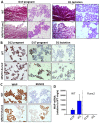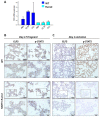RUNX2 correlates with subtype-specific breast cancer in a human tissue microarray, and ectopic expression of Runx2 perturbs differentiation in the mouse mammary gland
- PMID: 24626992
- PMCID: PMC4007404
- DOI: 10.1242/dmm.015040
RUNX2 correlates with subtype-specific breast cancer in a human tissue microarray, and ectopic expression of Runx2 perturbs differentiation in the mouse mammary gland
Abstract
RUNX2, a master regulator of osteogenesis, is oncogenic in the lymphoid lineage; however, little is known about its role in epithelial cancers. Upregulation of RUNX2 in cell lines correlates with increased invasiveness and the capacity to form osteolytic disease in models of breast and prostate cancer. However, most studies have analysed the effects of this gene in a limited number of cell lines and its role in primary breast cancer has not been resolved. Using a human tumour tissue microarray, we show that high RUNX2 expression is significantly associated with oestrogen receptor (ER)/progesterone receptor (PR)/HER2-negative breast cancers and that patients with high RUNX2 expression have a poorer survival rate than those with negative or low expression. We confirm RUNX2 as a gene that has a potentially important functional role in triple-negative breast cancer. To investigate the role of this gene in breast cancer, we made a transgenic model in which Runx2 is specifically expressed in murine mammary epithelium under the control of the mouse mammary tumour virus (MMTV) promoter. We show that ectopic Runx2 perturbs normal development in pubertal and lactating animals, delaying ductal elongation and inhibiting lobular alveolar differentiation. We also show that the Runx2 transgene elicits age-related, pre-neoplastic changes in the mammary epithelium of older transgenic animals, suggesting that elevated RUNX2 expression renders such tissue more susceptible to oncogenic changes and providing further evidence that this gene might have an important, context-dependent role in breast cancer.
Keywords: Breast cancer; Mammary development; RUNX2; Transgenic model.
Figures






References
-
- Barnes G. L., Javed A., Waller S. M., Kamal M. H., Hebert K. E., Hassan M. Q., Bellahcene A., Van Wijnen A. J., Young M. F., Lian J. B., et al. (2003). Osteoblast-related transcription factors Runx2 (Cbfa1/AML3) and MSX2 mediate the expression of bone sialoprotein in human metastatic breast cancer cells. Cancer Res. 63, 2631–2637 - PubMed
-
- Barnes G. L., Hebert K. E., Kamal M., Javed A., Einhorn T. A., Lian J. B., Stein G. S., Gerstenfeld L. C. (2004). Fidelity of Runx2 activity in breast cancer cells is required for the generation of metastases-associated osteolytic disease. Cancer Res. 64, 4506–4513 - PubMed
-
- Blyth K., Terry A., Mackay N., Vaillant F., Bell M., Cameron E. R., Neil J. C., Stewart M. (2001). Runx2: a novel oncogenic effector revealed by in vivo complementation and retroviral tagging. Oncogene 20, 295–302 - PubMed
-
- Blyth K., Cameron E. R., Neil J. C. (2005). The RUNX genes: gain or loss of function in cancer. Nat. Rev. Cancer 5, 376–387 - PubMed
Publication types
MeSH terms
Substances
Grants and funding
LinkOut - more resources
Full Text Sources
Other Literature Sources
Medical
Molecular Biology Databases
Research Materials
Miscellaneous

